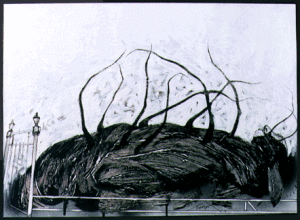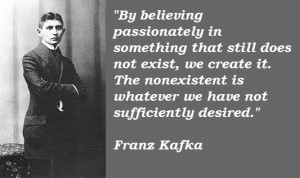Franz Kafka Google Doodle: Metamorphosis
Franz Kafka Google Doodle

On July 3rd 2013, the Google Doodle team played tribute to what would have been the 130th birthday of one of the finest nineteenth century, European authors, Franz Kafka. The Franz Kafka Google Doodle displayed a scene from Kafka’s Metamorphosis. The tale behind the Franz Kafka Google Doodle involves the unfortunate protagonist, Gregor Samsa, awakening to find that he has transformed into an undetermined insect.

The original German manuscript of Metamorphosis leaves the exact species of the insect ambiguous, “ungeheueren Ungeziefer”, which roughly translates as “monstrous vermin”. There has been much subsequent literary debate regarding the insects species.
In the Franz Kafka Google Doodle the Google logo is drawn in an insect like font and the first “O” is comprised of a door, through which the transformed Samsa walks in bug form, carrying a briefcase and wearing a bowler hat.
Franz Kafka was born on July 3rd 1883 in Prague, although now part of the Czech Republic, the city was part of the Austro-Hungarian Empire during this time. He had several siblings including two brothers, Georg and Heinrich and four sisters. His brothers died in infancy before Kafka was seven. He was born into a middle class Jewish family, he did not enjoy going to the synagogue and as a result his formal Jewish education ended abruptly with his Bar Mitzvah at the age of thirteen. After the completion of his elementary education in 1893 he attended Altstädter Deutsches Gymnasium, a secondary educational school which focused heavily on the classics. Although lessons were received in German, Kafka choose to speak and conduct much of his writing in Czech. Despite this, Kafka never felt he was able to speak Czech fluently and was said to speak it with a German accent. He attended the Gymnasium until 1901 and received generally good grades.

Following the completion of his education at the Gymnasium, Kafka went on to study at the Charles-Ferdinand University of Prague.
His education here began during 1901 and he began studying chemistry, however he transferred to law after just two weeks. Kafka graduated from the university on the 18th of July 1906 with a Doctorate of Law.
After his graduation Kafka went to work for an Italian insurance company, however he worked here for barely a year, before resigning. He resigned on the 15th of July 1908 and within two weeks had found himself employed by the Workers Accident Insurance Institute for the Kingdom of Bohemia. His role involved the investigation and assessment of compensation for workers who had received work related injuries, such as the loss of a finger. In 1911, he and Karl Herman became partners in the first asbestos factory in Prague. Although Kafka was initially highly motivated, he quickly became disgruntled with the role.
Kafka received early publication for his stories. His first public release occurred in 1908 and was a collection of eight stories which appeared in the first volume of literary journal, Hyperion. The stories appeared under the title of Betrachtung, which translates as “Contemplation”. His breakthrough work was the result of a burst of creative energy which occurred on the evening of September 22nd 1912, when he wrote the story “Das Urteil” which translate literally as “The Verdict”. The story was published later that year in Leipzig.

Continuing the creativity from which Das Urteil stemmed, Kafka penned the story “Das Verwandlung” better known as “The Metamorphosis”.
The story was written in 1912, although it was not published until 1915. The story, which features in the Franz Kafka Google Doodle, is widely regarded by many as one of the seminal works of twentieth century literature.
Other stories written by Kafka include, “In der Strafkolonie”, which translates as “In the Penal Colony”, written in 1914, although unpublished until 1919. It is a tale which explores an intricate torture and execution device. “Ein Hungerkunstler”, which translates as “The Hunger Artist”, was published in 1924.
Kafka also wrote a number of novels. The first of which, “Der Verschollene” which translates as “The Man Who Disappeared” or “The Missing Man”, he began writing in 1912. However the novel remained unfinished and was published posthumously under the title “Amerika”. Two years later, in 1914, Kafka began work on what was to become “Der Process” or “The Trial”, it was finished by 1915 but remained unpublished until 1925. The Trail, is one of Kafka’s best received works and recites the tale of a man who is prosecuted by an inaccessible authority, for a crime which is a mystery to both the character and the reader.
Kafka began writing what was to become “Das Schloss” (The Castle”) in 1922. His diary shows that he had begun to plan the story as early as 1914. The Castle tells the dark and surreal tale of a protagonist known only as “K”, who tries to gain access to the elusive authorities of a castle, which govern his village. Kafka died before he finished the book and it was published posthumously in 1926.
For much of his life, Kafka suffered from tuberculosis, a condition which prevented him from serving in the First World War. However his condition deteriorated over time, to the point that by March 1924 he returned to Prague to be cared for by his family members. His condition continued to deteriorate and he sought professional medical assistance from Dr. Hoffman, whose sanatorium he entered a month later. Franz Kafka died on the 3rd of June 1924, the cause of his death was attributed to starvation. Due to the severity of his throat infection, he found eating too painful and there was no alternative measure available at the time to provide nourishment.

Following his death, his body was returned to Prague, where he was buried on 11th June 1924. His grave still stands in the New Jewish Cemetery in Prague-Zizkov. Although some of his writings were published during his lifetime, he remained obscure whilst alive, however he soon became immensely popular after his death. He joins numerous other authors, writers and novelists with his Franz Kafka Google Doodle as they have also received dedicated Google Doodles, such authors as HG Wells, Oscar Wilde, Mark Twain and Bram Stoker.
